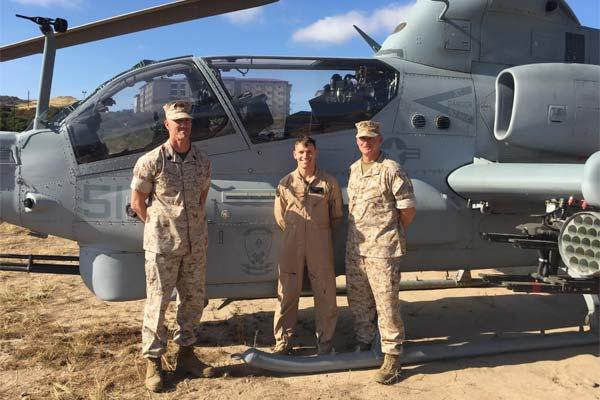Marine Corps pilots are getting a chance to see how the ground-pounders live in a new immersive program designed to bring the air and ground elements of the Corps' fighting machine closer for better collaboration.
Called the aviator immersion program, the initiative aims to have one pilot from each squadron within Camp Pendleton, California's Marine Aircraft Group 39 "embedded" with an infantry battalion at any given time. This month, the officials announced that Capt. Jason Grimes had become the first Marine pilot to complete the program after spending two months in training with 2nd Battalion, 5th Marines, also out of Pendleton.
The idea for the program originated with Col. Michael Borgschulte, commanding officer of MAG-39. It echoes thinking by previous Marine Corps Commandant Gen. Joseph Dunford and the current commandant, Gen. Robert Neller, who have both discussed their desire to see ground combat units coordinate more closely with air elements and take better advantage of the benefits of cutting-edge aviation platforms such at the MV-22B Osprey and the F-35B Joint Strike Fighter.
"We're nowhere near capable of fully realizing or leveraging the kinetic and non-kinetic capabilities of [the F-35]," Dunford told a Marine audience in May 2015.
Grimes, an AH-1Z Cobra pilot with Marine Light Attack Helicopter Squadron 369, said he spent his two months on the ground with 2/5 observing, learning, and acting as an informal forward air controller with the unit. He spent 19 days participating in grueling field training at the Marines' Mountain Warfare Training Center in Bridgeport, California, and another 11 days in Marine Corps Combat Readiness Evaluation and Fire Support Coordination exercises.
In a phone interview, Grimes told Military.com he was suprised to learn how much time infantry units spent in the field.
"We get so involved in our flight training we're a little bit removed from that," he said. " I've never seen a working battalion and how they operate."
During his time at the unit, Grimes also taught classes about the capabilities of the AH-1Z Cobra and what it can offer to Marines on the ground, emphasizing features such as the built-in sensors the aircraft carries and its significant payload.
"A lot of people don't understand the new capabilities it has," Grimes said. "If [infantry units] know what our sensors are or what our loadout can be, they can specifically request things from us. We can find targets or points of interest for them."
Since he returned to his own unit at the end of April, Grimes said he has made more of an effort to collaborate and communicate with infantry officers.
"If I'm building a scenario, I'm talking to the platoon commanders and company commanders I worked with to build a better scenario for what they would do," he said.
The experience also stoked his interest in returning to the role of forward air controller at an infantry unit at some future point in his career, he said.
A spokeswoman for 3rd Marine Aircraft Wing, 2nd Lt. Casey Littesy, said the aviation and ground units will also collaborate on "[Marine Air-Ground Task Force] integration exercises, executing long-range raid training, simulated tactical recovery of aircraft and personnel (TRAP) missions, and other training scenarios that complement their operational goals.
In another line of effort connected with the program, Littesy said, air and ground units air coordinating simulation training, so that air and ground units are encountering the same targets, threats and objectives in their simulators.
The aviator immersion program is set to continue indefinitely with units from MAG-39 and 5th Marine Regiment, with a pilot from Marine Light Attack Helicopter Squadron 169 set to report to 3rd Battalion, 5th Marines in July.
-- Hope Hodge Seck can be reached at hope.seck@monster.com. Follow her on Twitter at @HopeSeck.
Related Video:
Semper Fi Always Faithful






























